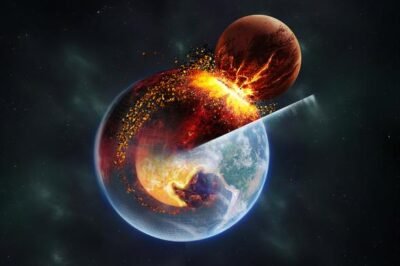
A groundbreaking study has shed new light on one of the universe’s most captivating mysteries: the birth of the Moon. Central to this enigma is the “giant impact hypothesis,” which posits that the Moon was formed following a colossal collision between the early Earth and a Mars-sized planet known as Theia. This cataclysmic event is thought to have scattered vast amounts of debris into orbit around Earth, which eventually coalesced to form the Moon. However, the fate of Theia itself has long puzzled scientists—until now.
Geophysicists in the 1980s stumbled upon a curious discovery deep within the Earth’s interior: two massive continent-sized anomalies, known as large low-velocity provinces (LLVPs), located near the planet’s core—one beneath Africa and another beneath the Pacific Ocean. Each of these enigmatic “blobs” is double the size of the Moon and composed of materials distinct from the surrounding mantle.
Published in the journal Nature, a new study proposes a riveting theory: these LLVPs are the remnants of Theia, still embedded deep within Earth’s mantle. This hypothesis not only supports the giant impact theory but also addresses the long-standing question of Theia’s disappearance, suggesting that rather than dispersing into the asteroid belt or contributing to meteorites, much of Theia was absorbed by the young Earth.
This revelation came to light through seismic wave analysis, a method that reveals the Earth’s inner structure by measuring how these waves travel at varying speeds through different materials. Anomalies in the speed of these waves in the 1980s first hinted at the existence of the LLVPs, with a notable high iron content suggesting their otherworldly origin.
Researchers from the California Institute of Technology (Caltech) undertook simulations to explore Theia’s chemical makeup and its catastrophic encounter with Earth. These models corroborated the notion that the LLVPs and the Moon could indeed be the products of this ancient collision. According to the study, parts of Theia’s mantle may have merged with Earth’s, while the remaining debris from the impact eventually formed the Moon.
This groundbreaking research not only provides insight into the Moon’s origins but also underscores the dynamic and tumultuous history of our own planet. The remnants of Theia, lying deep beneath Earth’s surface, serve as a testament to the cosmic forces that have shaped our world and its celestial companion.








































Leave a Reply